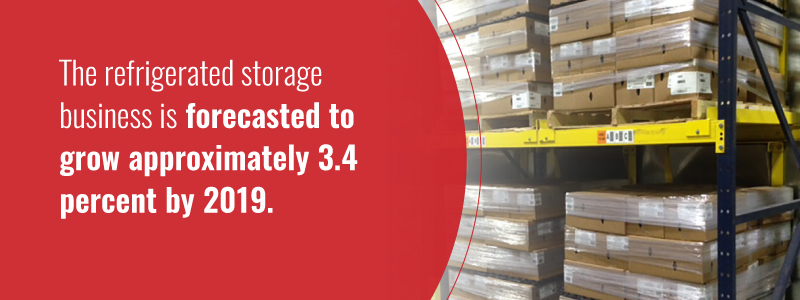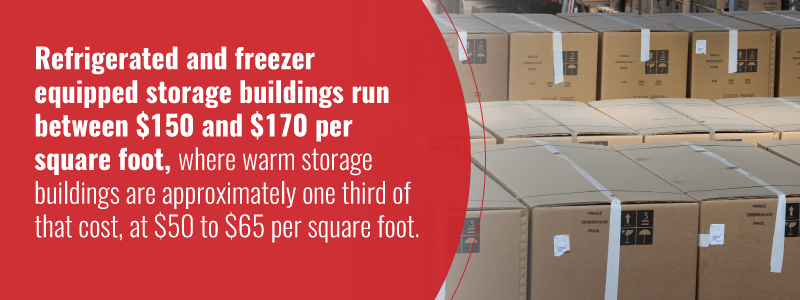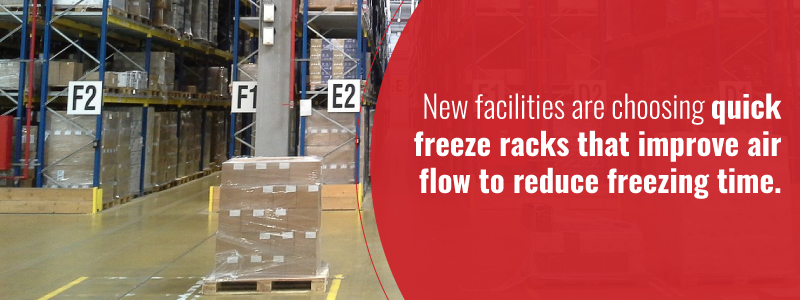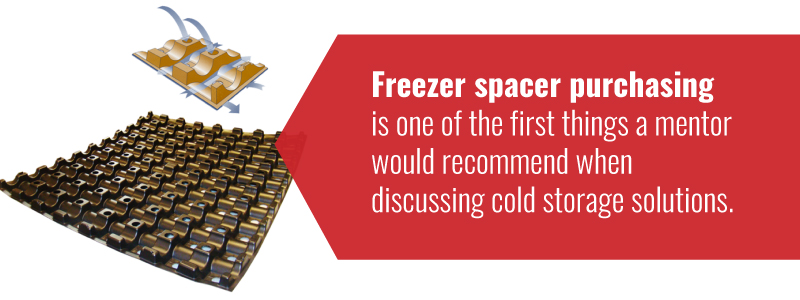Cold Storage Equipment Purchasing Guide

Cold storage is a highly specialized industry that requires specific skills and extensive management knowledge. Cold storage equipment purchasing is one of those knowledgeable skills. This can take years to learn and develop to the point where a cold storage facility is efficient as well as profitable. Cold storage facility managers need to be astute and on top of new technology and beneficial products. That includes knowing what to purchase, when to buy and who to source through.
Part of cold storage facility management’s overall responsibility is cold storage purchasing. That includes large undertakings like outfitting an entire warehouse and smaller tasks like choosing freezer spacers and freezer spacer removal equipment. Purchasers need to be aware of all types of freezer equipment — it’s a serious matter in a massive industry.
Explore our cold storage guide to learn more about the equipment best suited for your industry.

The cold storage industry is a large and vital component in America’s food distribution network. Demand for refrigerated space is growing enormously. The refrigerated storage business is forecasted to grow approximately 3.4 percent by 2019 and reflects the country’s escalating consumption of chilled and frozen goods. Consumer spending on frozen and refrigerated foods accounts for most of the cold storage industry’s annual revenue.
Predominantly, food manufacturers and wholesalers account for most of the country’s cold storage space, with retailers also being a prominent player. The pharmaceutical and floral producers require cold storage space as well, but not to the same degree as food producers. Frozen and refrigerated facilities cater to the meat, poultry, seafood, cheese and dairy producers as well as the prepared food segment.
Consumer sophistication regarding food products has changed over the past decade. The demand for canned and dried foods has slipped in favor of fresh products. Even the old “TV dinners” have been changed to offer restaurant-quality, gourmet meals that are flash frozen and made to last months. With this growing demand for cooled products, the requirement for proper facilities is growing at an exponential rate.
Responding to this demand is a challenge. Advancements in technology and maturing of logistic strategies greatly assist managers whose job is to provide cold storage of perishable items. These warehouse and production leaders are a critical link in the distribution chain. They’re responsible for making sure their facilities are clean, modern and safe, and they’re under strict government regulations with rigorous inspections.
Successful Cold Storage Management
Becoming a successful cold storage operator is the result of years of training and knowledge of the industry. The best cold storage managers have strong connections with vendors and suppliers of equipment, and they are diligent planners and sound decision makers. They are able to source and procure the best materials and machinery at an affordable price, making their warehouses and refrigerated facilities both efficient and profitable.
These knowledgeable managers rely on information from all sources. They attend conferences, visit other companies and are constantly on the hunt for ways to improve productivity and get the most use out of expensive space. Such managers plan and research in order to progress and grow. They are the ones who discover the tools of the trade that will make them excel in a competitive industry that is always changing.

Gleaning from quality cold storage equipment guides, operators learn the basics for purchasing cold storage equipment designed to make the handling of material easier, more economical and safer for all workers in the facility. They learn quickly that good equipment comes from excellent suppliers and that the right connections are the key to succeeding in the cold storage business. Couple the above with an effective plan and efficiency is assured.
Cold Storage Equipment Plan
Sourcing equipment through experienced and trustworthy suppliers involves knowing the industry and being receptive to ideas and suggestions. This requires a business plan that addresses the facility’s size and unique requirements. The plan looks at what is already in existence and then projects what will be needed in the future.
To operate within competitive industry standards a good cold storage equipment-purchasing plan considers critical factors such as space ratios and returns on investment. The plan then explores:
- Replacing worn equipment with new equipment
- Purchasing new equipment to service a coming business expansion
- Determining and adopting new technologies that have higher rates of return through automation and monitoring
Investment in new cold storage equipment is expensive. The first part of an equipment purchasing plan is looking at the overall industry and determining if the business is in a competitive situation for the exact commodity and location it’s operating within. Figures vary with regions, but some indicators are fairly universal.

Capital costs of financing a cold storage facility are much higher than for a dry and heated warehouse. National figures report that refrigerated and freezer equipped storage buildings run between $150 and $170 per square foot, where warm storage buildings are approximately one third of that cost, at $50 to $65 per square foot. These higher costs are directly due to the expensive machinery and equipment necessary to cool rather than heat a facility.
Air is much more expensive to cool than to heat. Cold storage facilities also use far more fuel in running compressors, condensers, fans and other critical components required to keep a facility’s temperature down to slightly above or well below the freezing point. Depending on the facility, there often are many different areas kept at varying temperatures to serve a specific commodity.
Flash-freezing is one technique that’s continually used to quickly freeze highly perishable products like meats and seafood. Operators use specialized equipment and accessories in the flash-freezing process. One example is the freezer spacer. Freezer spacers are relatively inexpensive but extraordinarily effective plastic “sheets” that aid in reducing expensive utility consumption.

Cold storage facilities are usually divided into two sections for practical reasons. One is “positive” rooms that maintain temperatures over the freezing point of +32 Fahrenheit or 0 degrees Celsius. The other is “negative” rooms where the temperature is always kept below freezing. Cold in these rooms is provided in two ways. One is “directly,” where a coolant chills products by evaporating, and the second is “indirectly,” in which air temperature drops from cooling it with a refrigerating medium.
Effective Use of Square Footage in Cold Storage Facilities
Part of planning cold storage equipment includes taking into account the effective use of square footage. In most parts of the building and storage industry, it is conventional to think of the facility’s footprint. The footprint calculation entails the square footage of floor space along with the building construction and purchasing costs. This formula is also used for assessing facility rental fees.

Cold storage facilities take a different approach in measuring their size. They calculate usable space in a three-dimensional or cubic system. The footprint square-footage is a starting point, but special consideration is given to the height of the facility, which translates to the volume of space available for storage. That volume of air has to be chilled at an expensive rate. That’s why cold-storage facilities are designed to take the maximum advantage of stackable space. It’s simply cheaper to go up than across.
It’s more economical to maintain proper temperatures in a small footprint facility. Thermal dynamic laws dictate that heat rises regardless of the temperature. Facilities that have broad footprints require more chilling equipment to maintain a consistent temperature across the lower band of the room. Facilities that have compact floor areas and use vertical space to their advantage benefit from lower energy costs.
In order to move supplies onto these vertical racks, it will be necessary to remove any freezer spacers. This can be accomplished using a freezer spacer removal system from Cherry’s Industrial.
New Technologies in the Cold Storage Industry
Conventional rack warehouse facilities are nowhere near as expensive to operate as cold storage warehouses are. Cold storage requires highly complex, sophisticated equipment that responds to critical points in temperature. The failure of one small component in a refrigeration or freezer unit could mean the loss of thousands of dollars in valuable, temperature-sensitive products.

Technology quickly advances to better serve chilling units, making them more efficient and more reliable. It also makes them more expensive. Keeping expenses in line and still benefiting from new technology is every manager’s challenge. Planning for these changes is a prudent business procedure, and so is being aware of four cutting-edge, cold storage technologies that need to be planned for:
-
- Quick Freezing Racks (QFR) are replacing the way blast freezing is done. New facilities are choosing quick freeze racks that improve air flow to reduce freezing time. They allow a higher operating environmental temperature to produce faster freezing while consuming less power consumption. QFR technology drastically lowers energy costs, offers faster product turns and better uses floor space. They have lower costs on installation and provide continuous freezing capability without any more batch cycles. Quick Freezing Racks can also be used as pallet storage if quick freezing isn’t needed.
- Wireless Radio Frequency Identification (RFID) is a system that uses scanned tags that relay information about product inventory and movement. Less time is spent tracking and monitoring temperature fluctuations and transit data. Cold storage facility managers have much better product and quality control using a RFID technological system.
- Cross-docking is a technology that integrates automatic barcodes for product storage and retrieval. This guides vehicles to move goods from the receiving dock to the storage area and then to the shipping dock without having to be visually or manually inventoried. Cross-docking using barcodes saves a tremendous amount of time and severely reduces expensive labor costs.
- Product picking improvements involve voice-activated robotics. These hands-free machines let cold storage workers command and control order pickings and processes without removal thermal gloves and risking exposure injury. Robots are one of the most promising technological advancements in the cold storage business that will save time and expenses as well as contribute to worker safety.
Making Networking Part of the Cold Storage Equipment Purchasing Plan

The best business owners and managers are excellent networkers. They are great communicators as well. A good portion of being able to source and purchase equipment for a cold storage facility is developing a network of people within the cold storage business community who have similar interests and different knowledge. They find the right go-to people and turn to them when buying or otherwise procuring cold storage equipment.
Networks are built over time and with specific goals in mind. Part of the value in networking comes from knowing who the most reputable equipment suppliers are and who their competent representatives are. Cold storage equipment may be a commodity, but people are not. Getting connected to the right people in the industry is a vital part of the equipment purchasing plan. Some suggestions of people to network with are:
-
-
- Sales representatives with industry-specific skills and knowledge
- Manufacturer’s technical personnel who understand the equipment mechanics
- Delivery staff who ensure the right products are shipped on time and in order
- Customer service agents who can add value to purchase details
- Other business owners and managers in the cold storage industry
- Technology developers who are working on future equipment designs and improvement
-
Mentoring is an often-overlooked form of networking. Finding a mentor who has been in the cold storage business for years can be a priceless resource when it comes to buying equipment that gives dependable and cost-effective service. Good mentors can be hard to find, but they’re worth every effort in helping to recommend what equipment works and is worth buying. They’re also excellent resources for advising on what doesn’t work and what to stay away from.
Cherry’s Industrial has been in the storage equipment business for more than 20 years and can be a valuable mentor when it comes to cold storage solutions. A great mentor in the cold storage business, such as Cherry’s Industrial, knows how to make the cold storage business a practical and profitable experience. For example, every mentor would recommend purchasing freezer spacers to separate frozen foods while they’re in the freezing process. Freezer spacers are an essential commodity that significantly improves freezing time while consuming little space.
Utilizing Freezer Spacers

Freezer spacer purchasing is one of the first things a mentor would recommend when discussing cold storage solutions. These problem-solvers separate stacks of products while they’re being frozen and can be easily removed when the goods are solid. Freezer spacers can be stacked in compact locations or be immediately returned to service to allow other products to be frozen while their predecessors sit in storage.
A mentor would also recommend a manager choose freezer spacer removers to make the process complete. They virtually eliminate manual labor in handling frozen foods. They also free up valuable dock space so the entire area can be used more efficiently. This tighter control is an objective a good mentor can help with and makes the investment in expanding a purchasing network so worthwhile.
Warranty Considerations When Purchasing Cold Storage Equipment
A major consideration every purchaser must take into account is the warranty provisions that back their equipment’s performance. Cold storage equipment can be expensive, not just to purchase but also to repair. Although quality equipment usually is trouble free, there are times when even the best products fail. This is when good warranty coverage can be an invaluable asset.
Understanding the warranty policies should be part of every equipment purchase plan. Most warranties are set for fixed time limitations. They also have clauses that identify exactly what’s covered and what’s not. Some warranty coverages are pro-rated or cover fewer of the costs or conditions as the product runs through its design life cycle.
Reputable cold storage and material handling equipment suppliers like Cherry’s Industrial Equipment offer clear and comprehensive warranties for all items. Cherry’s includes excellent warranties on all their equipment from straightforward devices like freezer spacers as well as for more complex machines like freezer spacer removers.
A good warranty protects a manager who knows how to purchase their cold storage equipment. Warranty coverage is included in the planning process, and it’s a necessary part of the procurement procedure. Not all warranty provisions are equal between suppliers or from the equipment manufacturers. Details can vary, and a wise mentor will recommend reading the fine print.
Cold Storage Facility Purchasing Requirements
Cold storage facility operators have specific purchasing requirements that are unique to the business. Often, the needs are specific to that exact niche business and its location. These managers know that part of their planning focuses on the future. They analyze what’s going to be needed five to ten years ahead and make contingencies when purchasing equipment.
Included in that contingency is networking with an industry-leading supplier to the cold storage industry. That supplier is Cherry’s Industrial Equipment, who knows and understands the uniqueness of the nation’s massive cold storage industry. The knowledgeable staff at Cherry’s has mentored and networked with many cold storage managers and owners.
Cherry’s understand that economics and efficiency are the driving force behind automation in the cold storage business, just like it is in every business today. Cherry’s has been supplying top-quality equipment to this extremely important part of America’s food processing and distribution system since 1983. Over three decades, Cherry’s Industrial has worked with industry leaders to design and supply the most efficient and highest quality equipment and accessories.
Cherry’s believes in a win-win business attitude that makes a profitable and long-lasting partnership between suppliers and their valued customers. When freezing and moving frozen food, Cherry’s Industrial Equipment strives to win customer confidence and turn their facilities into thriving businesses.
In conclusion, all quality cold storage equipment is designed for 3 fundamental purposes: 1) Increasing Overall Efficiency and Productivity, 2) Lowering costs by reducing manpower requirements, and 3) Enhancing safety in the work place. These are 3 of Cherry’s main objectives in serving the food and cold storage industry.
Supplying material handling equipment for frozen products is a serious matter at Cherry’s. For all your cold storage equipment purchasing solutions, let Cherry’s guide you with our knowledgeable and experienced service staff. Check out our freezer spacer removal systems and request a quote today.
